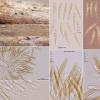
23-05-2018 19:32
Hi againMinute semi-inmersed pseudothecia (up to 2

11-06-2018 17:52
Paul CannonHere is a very distinctive disco on twigs of Pinus

16-06-2015 20:07
Have you some idea about this fungus growing on le

10-06-2018 21:24
 Riet van Oosten
Riet van Oosten
Hello, Found 10-06-2018 on Typha, The Netherlands

10-06-2018 21:49
François BartholomeeusenDear forum members, I suspect it is a Pyrenopeziz

10-06-2018 18:28
 Blasco Rafael
Blasco Rafael
Hola, esta horbilia estaba sobre madera de Salix m

08-06-2018 18:33
Hi to everyoneThis enigmatic diaporthale makes sub

08-06-2018 13:25
 Blasco Rafael
Blasco Rafael
Hola, necesitaria su confirmacion para esta muestr
Leptosphaeria on Tamus communis
Enrique Rubio,
23-05-2018 19:32
Minute semi-inmersed pseudothecia (up to 200 microns in diam) with only the obtuse papilla visble, on stems of Tamus communis (Dioscorea c.).
The golden light ascospores are (1-)3-septate, the second cell slightly enlarged, with obscure apical conical appendages.
It seems to match with the plate 0506 in last Bjorn Bwergen's book on Pyrenomyecetes, under the name Leptosphaeria scitula on Chelidonium. But the spore (and asci) size is larger than Holm and Shoemaker's descriptions.
What do you think?
Thanks again for help me.
Mlcoch Patrik,
11-06-2018 21:00

Re : Leptosphaeria on Tamus communis
I thing, that this can be Paraleptosphaeria nitschkei, or so something from this agregation. I have collection this species from the Papaver orientale, but most common are collections from Asteraceae. It would be very interesting this your collection sequencing, i should interested in this collection, because I interested in the genus Leptosphaeria and I this genus want to process in detail.
On Tamus was found only Leptosphaeria tami, but it has shorter hyaline spore (17 x 4,5 um) and 4-septate. P. nitschkei has spore 3-5 septate and 28-36 x 3-4 um large. Your collection has characteristics of morfology of spore for P. nitchkei.
On Tamus was found only Leptosphaeria tami, but it has shorter hyaline spore (17 x 4,5 um) and 4-septate. P. nitschkei has spore 3-5 septate and 28-36 x 3-4 um large. Your collection has characteristics of morfology of spore for P. nitchkei.
Enrique Rubio,
12-06-2018 13:25
Re : Leptosphaeria on Tamus communis
Hi Patrik
Thank you for your help.
If you want I send you a part of my collection, please, give me your postal address.
Regards
Enrique
Thank you for your help.
If you want I send you a part of my collection, please, give me your postal address.
Regards
Enrique



